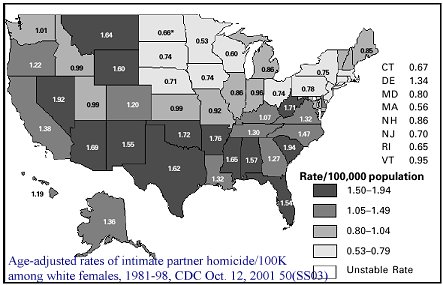
It seems that each year brings a distinctive theme regarding family life. Without question, 1994 was the Year of Family Violence, featuring such stories as:
|
LOOKING AT OUR LANGUAGE "rule of
thumb":
English orig..,
where law specified "naboot": ancient
Egyptian
orig., a wooden stave |
The following year, in 1995, President Clinton proclaimed October the National Domestic Violence Awareness Month. The following year, included in the Personal Responsibility and Work Opportunity Reconciliation Act, were Family Violence Provisions, recognizing the connection between family violence and the impoverishment of women and children. According to a 1996 Justice Department report, "Victim Costs and Consequences: A New Look," child abuse and domestic violence account for about one-third of the total annual costs of crime. And in 1997 the U.S. Department of Justice released results of a study, "Violence-Related Injuries Treated in Hospital Emergency Departments", wherein it was reported that 1.4 million Americans were treated for non-fatal injuries incurred from confirmed or suspected violence. Among those victims where the relationship with their aggressor was known, two-thirds were injured by someone they knew. Approximately one-quarter of these cases involved assaults by someone with whom the victims had an intimate relationship (e.g., spouse, ex-spouse, or current or former boy or girl friend)--a figure four times higher than what had been estimated by the National Crime Victimization Survey.
The rates are far from uniform across the social geography. According to a 2001 study of the CDC, one out of three female murders in the U.S. are intimate partner homicides (IPH). Risk of IPH increases with the population of the couples' residence, with the risk for those living in cities greater than 250,000 being two to three times greater than for those living in cities with fewer than 10,000 residents. Further, as can be seen below, rates were highest in the Western and Southern states. Rates for blacks during the 1981-98 period studied were 4.6 times that of whites. The encouraging finding was that over the 17-year time-frame rates of intimate partner homicides decreased by nearly 50%.
Roughly every 12 seconds in the United States, some man batters his current or former wife or girlfriend. Such assaults are currently the leading cause of injury to American women--more than injuries due to muggings, auto accidents, and rape by strangers combined--sending more than one million to doctors offices or emergency rooms every year for treatment (an estimated one-third of all women seeking emergency treatment at doctors' offices are victims of domestic violence, as is one-quarter of all those seeking prenatal care). Consider the following statistics:
(The above compilation from the newswires was made by Joe Patrick Bean. 1994. "Take steps against domestic violence." San Antonio Express-News [Sept. 29]:5B).
Such victimization, of course, is not new. Husbands' abuse of wives was sanctioned throughout much of American history, especially if it was "correctional;" for the Puritans, it was seen to contribute to the maintenance of community standards. The feminist movement developed, in part, in the 1860s out of a desire to stop this socially-tolerated violence. Susan B. Anthony claimed it was symptomatic of patriarchal structures. The movement provided not only an ideology but underground railroad escapes for abused wives. It largely died during the first half of the twentieth century, and it was not until the 1970s and 1980s that laws were past against such aggression. Before 1979 only Iowa, Nebraska, Oregon, New Jersey, and Delaware had laws allowing prosecution of husbands for raping their wives; between 1980 to 1985, eighteen additional states were to pass such legislation.
Not only are women for likely to be victims in the family battlefield, but there is evidence that such victims of domestic violence face discrimination when trying to obtain insurance coverage.
Homicide is the leading cause of death by injury of American infants under the age of one.
One wonders about the extent to which corporeal punishment socializes individuals toward violence. Extrapolating from a 1995 Gallup survey of parents nationwide (n=1,000), more than three million American children are physically abused each year in the name of discipline, and almost 5 percent are punished by punching, kicking or being thrown down, or by hitting with a hard object on some part of the body other than the rear end.
Let us consider the results of the 1986-94 NORC General Social Surveys (n=8,061) of Americans' responses to the following question:
Do you strongly agree, agree, disagree, or strongly disagree that it is sometimes necessary to discipline a child with a good, hard spanking?
From these random samples of American adults we find:
Click here to see the extent to which education explains the racial differences in endorsing spanking.
To this sad inventory of victims of familial violence are the older, and often most vulnerable adult members. According to a 1995 AP report, reports of such domestic abuse increased from 117,000 in 1985 to 241,000 in 1994. The actual figures are undoubtedly much higher--perhaps as many as one out of ten older Americans suffer some kind of abuse. An estimated six in seven instances of elder abuse or "granny bashing" are committed by family members. Fearful of being left alone or placed in an institution, embarrassed and ashamed of their plight, older family victims are at a distinct disadvantage in family power games. In 1993, the National Center on Elder Abuse was established by the Administration on Aging. Elder Abuse Prevention: Information and Resource Guide
Not Forgotten from the Texas Dept. of Protective and Regulatory Services
Prepublication (2002) release of Elder Mistreatment: Abuse, Neglect, and Exploitation in an Aging America from the National Academy Press
![]()